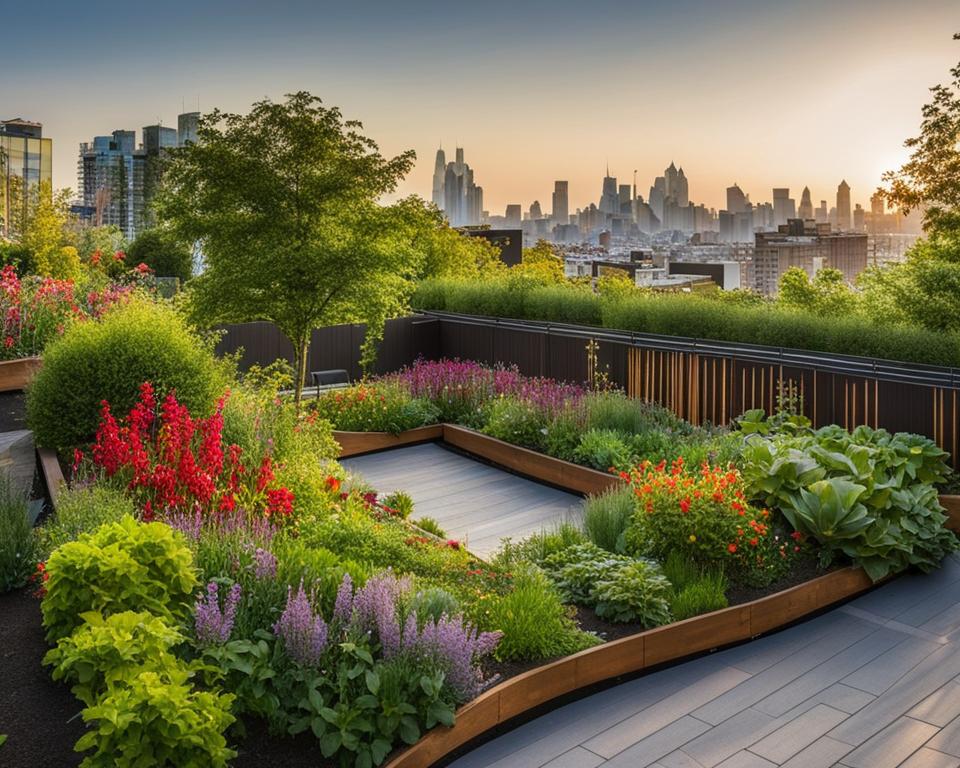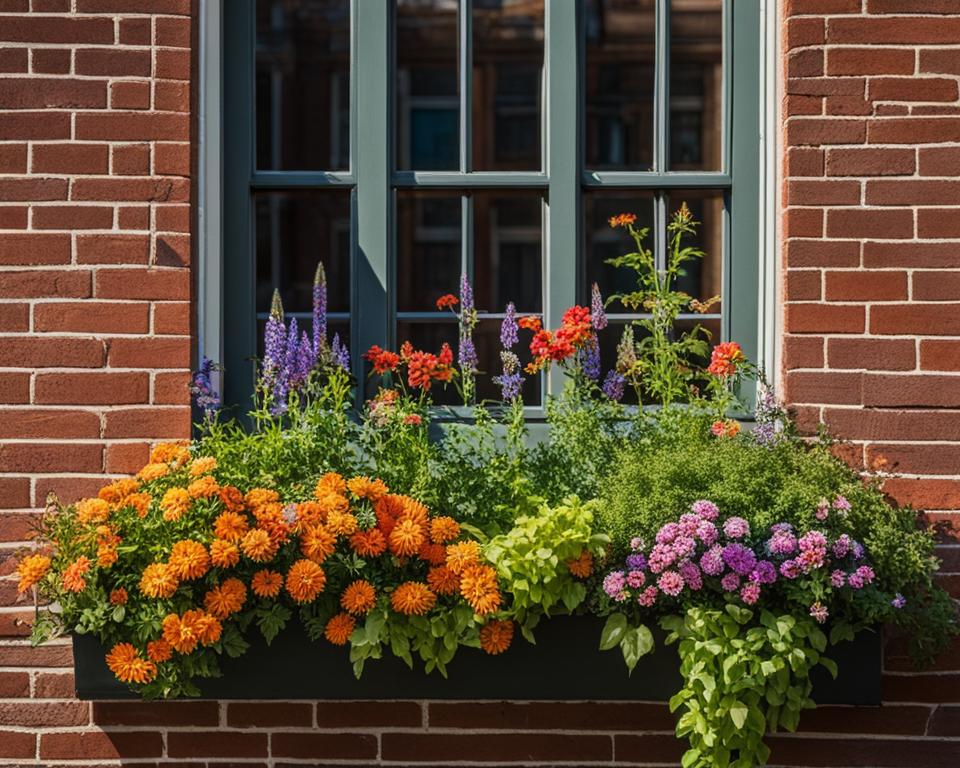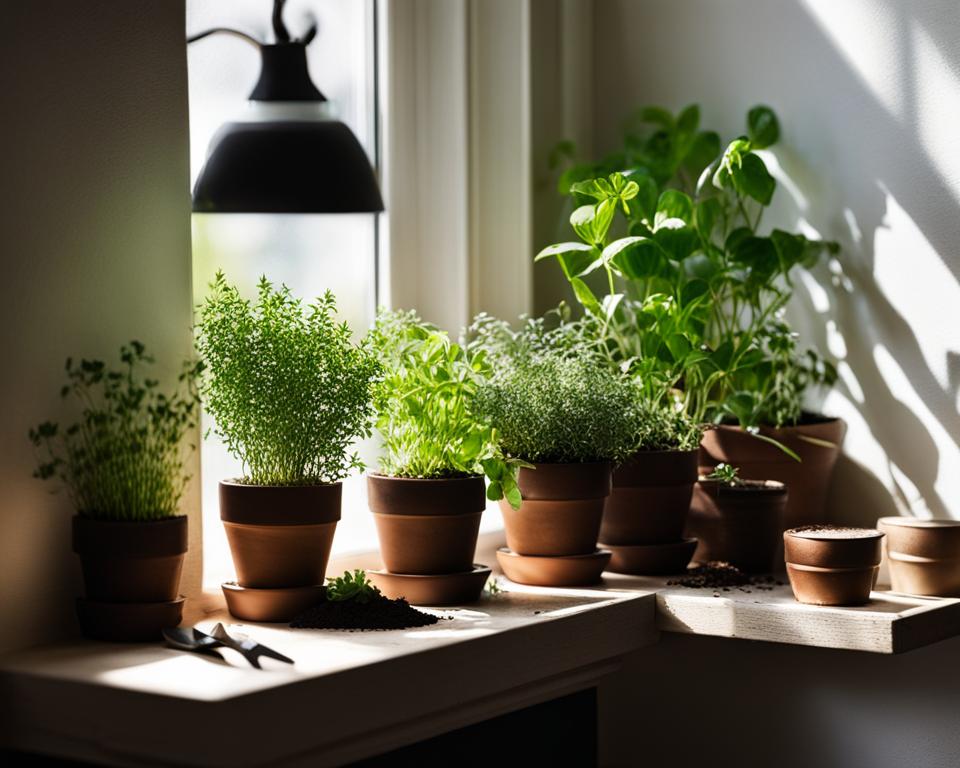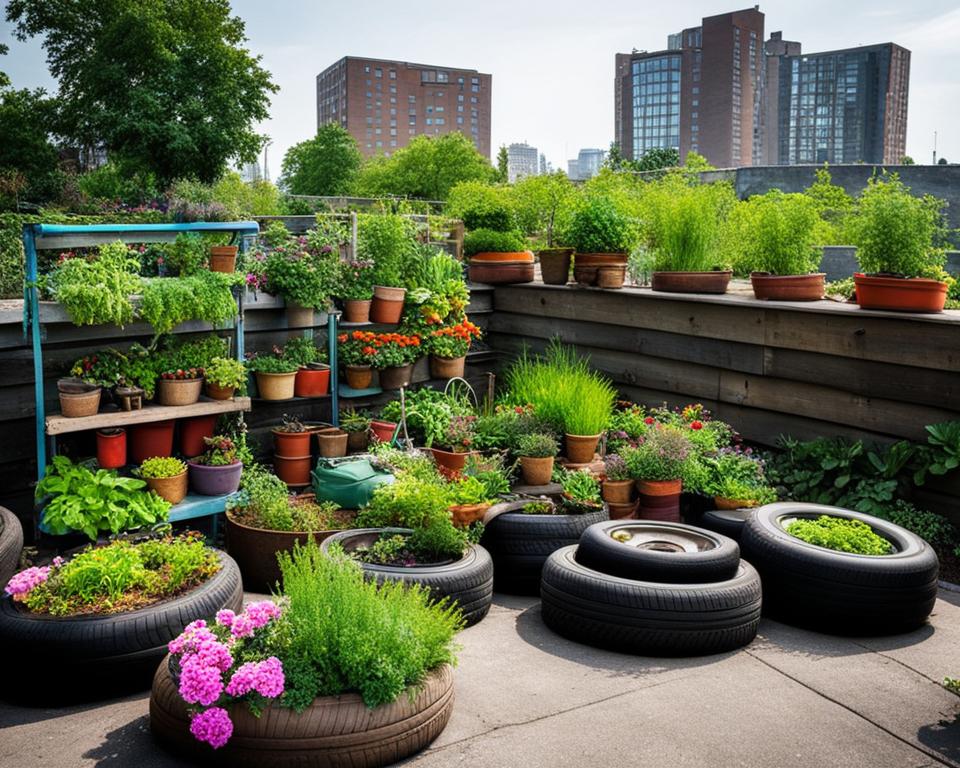Urban environments often leave gardening enthusiasts with limited space to work with. But that doesn’t mean you can’t create a lush, green oasis in your city living space. By adopting clever and innovative urban gardening ideas, you can maximize the potential of your small space and bring life to your apartment, balcony, rooftop, or shared community garden. Combining vertical, container, and indoor gardening techniques with eco-friendly practices and recycled materials, it’s entirely possible to build a thriving urban jungle that’s both beautiful and functional.
Key Takeaways
- Urban gardening ideas can help you make the most of your limited city living space.
- Vertical gardening, like living walls, can maximize the use of available space in your small garden.
- Container gardening allows you to grow a variety of plants in areas such as patios, balconies, and rooftops.
- Indoor herb gardens are perfect for adding some greenery and fresh ingredients to your kitchen.
- Repurposing common household items into planters can give your urban garden a unique and sustainable touch.
Maximizing Greenery with a Living Wall
Living walls, also known as green walls, are a smart solution for incorporating greenery into urban settings where ground space is scarce. These vertical gardens not only add a touch of nature to city dwellings but also promote sustainable urban gardening practices. This section will discuss the process of choosing the right plants for vertical growth, using self-watering systems for easy maintenance, and incorporating recycled materials for sustainable urban gardens.
Choosing the Right Plants for Vertical Growth
Selecting the appropriate plants is crucial for a thriving green wall. Small-root varieties such as money plants, ferns, bromeliads, and spider lilies excel in these vertical environments. Additionally, mixing and matching flowering and non-flowering species creates visual interest on your living wall. Consider the following table for a selection of plants suitable for vertical gardening:
| Plant Name | Type | Growth Habit | Special Characteristics |
|---|---|---|---|
| Pothos (Epipremnum aureum) | Foliage | Trailing | Low light, easy maintenance |
| Bromeliads | Flowering | Rosette | Colorful and exotic |
| Spider Plant (Chlorophytum comosum) | Foliage | Arching | Adaptable and purifies air |
| Ferns | Foliage | Various | Lush and dramatic, adaptable to different light conditions |
Using Self-Watering Systems for Easy Maintenance
Cultivating a living wall in an urban space doesn’t have to be labor-intensive. Incorporating self-watering systems can reduce the time required for plant care, making green walls an attractive option for busy city residents. These systems also reduce water waste and ensure consistent moisture for optimal plant growth. Several options for self-watering systems include:
- Drip irrigation systems that deliver water directly to plants’ roots.
- Wick systems, consisting of a reservoir and a wick that transports water to the plants.
- Capillary mats, placed under plants to provide constant moisture.
Incorporating Recycled Materials for Sustainable Urban Gardens
Using recycled materials for living walls not only minimizes environmental impact but also adds character to urban gardens. Old bottles, repurposed shoe organizers, and even upcycled plastic containers can be transformed into vertical garden fixtures, enhancing sustainability and sparking creativity in small-space gardening. Some eco-friendly planter ideas include:
- Creating plant pockets from used plastic bottles or repurposed PVC pipes.
- Upcycling wooden pallets into vertical planter structures.
- Converting an old shoe organizer into a wall-mounted herb garden.
By integrating reclaimed materials into your green wall, you promote sustainable urban gardening practices and contribute to a cleaner, greener city.
Container Gardening: A Versatile Approach to Urban Green Spaces
When it comes to urban green spaces and versatile gardening, adopting container gardening methods is perfect for city dwellers looking to make the most out of their limited space. Utilizing pots, barrels, boxes, and buckets, a variety of plants can thrive, provided they have enough room and proper drainage.
“Container gardening is an excellent way to bring the beauty of nature into urban environments. Not only does it allow gardeners to maximize their space, but it also offers unique opportunities for creative expression and customization.”
There are numerous advantages to container gardening, including:
- Cooler plant roots: In double-potted systems, the outer pot shields the inner pot from sunlight, keeping the roots cooler and healthier.
- Portability: Easily move or rearrange your garden as needed, allowing you to adapt to changing conditions or personal preferences.
- Unique displays: Hanging arrangements crafted from wooden boards and rope can be used to create stunning and space-saving garden displays.
- Organic urban gardening: Container gardening provides an accessible way to grow your own food, reducing your reliance on store-bought produce and supporting a sustainable lifestyle.
Container Gardening Tips
To set yourself up for success in urban container gardening, consider these helpful tips:
- Select containers with drainage holes, or add them yourself, to prevent root rot caused by standing water.
- Use high-quality potting soil designed for container gardening, as it retains moisture better than traditional garden soil.
- Choose plants that match the lighting, temperature, and humidity conditions of your urban environment.
- Group plants with similar water, sun, and nutrient needs together in containers to simplify maintenance.
| Plant | Container Size | Watering Frequency | Lighting Needs |
|---|---|---|---|
| Tomatoes | 18-24 inches | Every 2-3 days | Full sun |
| Peppers | 12-24 inches | Every 3-4 days | Full sun |
| Herbs | 6-12 inches | Every 3-7 days | Partial to full sun |
| Flowering annuals (e.g., petunias) | 12-18 inches | Every 2-3 days | Full to partial sun |
| Green leafy vegetables (e.g., lettuce) | 8-15 inches | Every 3-4 days | Partial sun to shade |
With these container gardening tips, you can transform your patio, balcony, or rooftop into a thriving urban green space, promoting health, well-being, and sustainability in your city living environment.
Creating an Oasis with Rooftop and Balcony Gardens
Tackling the challenges of rooftop and balcony gardening takes thoughtful planning to provide you with an urban oasis in the bustling city landscape. Considering crucial factors such as weight limits, wind resistance, sunlight optimization, and shelter from harsh elements can result in a thriving and attractive garden in your elevated growing space.

Design Considerations for Weight and Wind Resistance
To ensure the safety and stability of your balcony or rooftop garden, it’s crucial to choose lightweight planters made from materials such as wood, fiberglass, or foam. Combine these with lightweight potting soil to minimize overall weight. Windbreaks, such as lattices or trellises, play a significant role in maintaining airflow while protecting your plants from harsh wind conditions. For balcony gardens, placing saucers beneath containers can help prevent water-related issues with neighbors residing below.
Optimizing Sunlight and Protecting Against the Elements
Selecting plants that can thrive in variable conditions is vital for successful rooftop and balcony gardening. Choose varieties that can withstand full sun exposure and the fluctuating temperatures encountered in elevated and exposed environments. To ensure your garden remains hearty and attractive year-round, consider the following city gardening tips:
- Group sun-loving plants in areas with maximum sunlight exposure.
- Shield delicate plants from excessive wind or rain with wind barriers or temporary shelters.
- Monitor and adjust plant placement throughout the year to maximize sunlight exposure and minimize harm caused by seasonal weather changes.
By adhering to these design considerations and protection strategies, you can transform your rooftop or balcony into a lush, green oasis amidst the urban jungle. Enjoy the sense of tranquility and well-being these elevated gardens can provide, and appreciate the creative possibilities offered by city living.
The Charm of Window Box Planting
Window box planting offers an enchanting solution for those with limited space, bringing vegetation to the urban landscape without requiring a balcony or patio. City dwellers can enjoy a variety of plants within arm’s reach, effectively transforming their window views into scenes of natural beauty while keeping plants safe from animals and offering ease in maintenance.

Charming urban gardens can be easily achieved through window box planting, providing an attractive and practical option for those with small living spaces. An excellent way to enhance the appearance of your home, window box planters bring color and life to any city dwelling, creating a pleasant environment for both you and your neighbors to enjoy.
“A garden is a grand teacher. It teaches patience and careful watchfulness; it teaches industry and thrift; above all it teaches entire trust.” – Gertrude Jekyll
When beginning your window box planting journey, consider selecting plants that thrive in your area’s climate and can tolerate the unique conditions created by an urban environment. To ensure success, research the specific sunlight, water, and temperature needs of your chosen plants and match them with your location accordingly.
- Determine the sun exposure for your window: full sun, partial sun, or shade.
- Select plants that are suitable for the specific sun exposure of your window.
- Choose plants that are appropriate for your region’s hardiness zone.
- Plan for adequate drainage to prevent root rot.
- Consider how much maintenance you are willing to do; some plants require more care than others.
Window box planting is a versatile small space solution for urban gardening enthusiasts. By customizing their choice of plants and planter design, city dwellers can create a personalized, lush oasis within the constraints of their living situation.
| Plant | Sun Exposure | Moisture Needs | Maintenance Level |
|---|---|---|---|
| Geranium | Full Sun | Moderate | Low |
| Petunia | Full Sun | Moderate | Low |
| Fuchsia | Partial Sun | High | Medium |
| Begonia | Partial Sun | Moderate | Low |
| Impatiens | Shade | High | Low |
In conclusion, window box planting is an excellent way for urban dwellers to infuse their living spaces with color and life, even if their square footage is limited. By selecting the appropriate plants and providing proper care, your charming urban garden will become a point of pride and enjoyment, both for yourself and passersby.
The Magic of Miniature: Starting an Indoor Herb Garden
Having your own indoor herb garden is a fantastic way to add flavor and greenery to your kitchen. By efficiently utilizing windowsills or installing hanging planters, city residents can grow a variety of fresh herbs, such as mint, rosemary, basil, and thyme. This offers not only a visually pleasing culinary garden but also easy access to fresh ingredients for cooking.

Growing a Culinary Garden in Your Kitchen
Mason jar planters are an excellent choice for year-round cultivation of kitchen herbs, adding both practicality and aesthetic charm to your indoor herb garden. They provide a reusable and sustainable option, making them perfect for urban herb growing enthusiasts who seek environmentally-conscious solutions.
“Growing your own indoor herb garden is not only a delightful visual addition to your kitchen but also a convenient source of fresh herbs for cooking and seasoning.”
Indoor Gardening Techniques for Herbs with Limited Space
When dealing with limited space, indoor gardening techniques such as repurposing household items are essential for establishing a compact yet productive herb garden. Utilize these inventive methods to turn even the smallest city apartments into personal greenhouses:
- Shoe organizer herb planters: A hanging shoe organizer can be transformed into a space-saving vertical garden, perfect for growing a variety of herbs.
- Repurposed containers: Common items such as tin cans, plastic bottles, and even teacups can serve as unique planters for your indoor herb garden.
- Tiered stands: Utilize multi-tiered stands to hold multiple pots, creating a compact yet visually appealing herb garden display.
Combining these methods yields efficient and decorative herb cultivation, suitable for city dwellers who desire a functional and attractive kitchen gardening experience.
Rethinking Resources: Utilizing Unconventional Planters
Urban gardening enthusiasts can take a sustainable and personalized approach to their small green spaces by embracing the use of unconventional planters. Repurposing everyday objects into creative plant containers not only adds character to your urban garden but also reduces waste and contributes positively to the environment.

Repurposing Objects into Creative Plant Containers
Upcycling used items into planters can turn your urban garden into a green oasis, infused with ingenuity and personality. Try identifying household items that could be transformed into unique and lively plant containers by thinking outside the box. Some ideas for DIY gardening projects include:
- Old mason jars as succulent or herb planters
- Shoe organizers as vertical gardens for herbs and flowers
- Tin cans as rustic containers for small plants
- Drawers from broken or discarded furniture redesigned into planter boxes
- Plastic bottles and containers cut and repurposed into hanging planters
The possibilities for upcycled planter ideas are vast and can be tailored to your specific tastes and decorating style.
Environmental Benefits of Upcycled Gardening
Choosing upcycled gardening as an urban garden hack adds more than just a distinctive look to your green space; it also contributes to environmental sustainability. Turning waste materials like plastic and glass containers into unconventional planters reduces the amount of waste that ends up in landfills and lowers your ecological footprint. By choosing sustainable planters, you are promoting a greener approach to urban living and helping to conserve our planet’s resources.
Upcycled gardening not only adds a distinctive look to urban green spaces but also contributes positively to the environment. By reusing materials that might otherwise contribute to landfill, urban gardeners can reduce their carbon footprint while cultivating a lush and productive garden within the city.
Explore the world of unconventional planters, DIY gardening, and urban gardening hacks to create a more sustainable and personalized urban garden. Your green space will not only be a haven for you and your plants but will also contribute to a healthier environment and greener living.
The Innovation of Mason Jar and Hanging Planters
With space often being a challenge for city dwellers, mason jar planters and hanging planters innovations have emerged to provide chic and practical solutions for urban garden décor. These options enable gardeners to make the most of the limited space available in their apartments or balconies while also enhancing the visual appeal of their urban gardens.
Mason jars have gained popularity as a versatile and stylish option for planting small-scale herb gardens or sprouting seeds. Their compact size allows them to be displayed both indoors and outdoors, adding a unique touch to your urban garden. To create an attractive mason jar planter, simply add some gravel or pebbles to the bottom of the jar for drainage, fill with potting soil, and plant your preferred herbs or sprouts.
“Urban gardeners are increasingly turning to mason jar planters for their space-saving and visually appealing benefits.”
For those looking to further maximize vertical space, hanging planters are the perfect innovation. Available in a variety of materials, such as metal, wood, or woven baskets, hanging planters offer the convenience of keeping plants off the ground and creating an eye-catching display.
- Classic metal hanging planters with chains or ropes, suitable for both indoor and outdoor use.
- Handcrafted wooden hanging planters, adding a rustic charm to your urban garden.
- Woven baskets or macramé plant hangers, providing a bohemian vibe in the urban green space.
By combining mason jar planters and hanging planters, urban gardeners can create a stunning visual display while making efficient use of limited space. Regardless of the size of your city living space, these innovative solutions can help transform your apartment or balcony into a beautiful green oasis, perfect for relaxation and connection with nature.
Conclusion
With a touch of imagination and urban gardening inspiration, city dwellers can transform their limited spaces into lush green havens. Creative green solutions such as container gardening, living walls, and rooftop gardens allow urbanites to maximize the potential of their city living spaces while enjoying the myriad benefits of cultivating their own green oases.
Taking advantage of unconventional planters, upcycled materials, and indoor herb gardens further expands the possibilities for urban gardening, empowering individuals to adapt their city homes into functional and beautiful expressions of their green passions. The end result is not only a more aesthetically pleasing living environment but also one that contributes to a healthier lifestyle and a more sustainable planet.
So, go ahead, unleash your creativity and start exploring the exciting world of urban gardening. Discover how simple it can be to grow your own plants, flowers, and herbs right in the heart of the city, nurturing a personal connection to nature amidst the hustle and bustle of urban life. With a little effort and vision, even the smallest city spaces can become a thriving green sanctuary, demonstrating that the possibilities for urban gardening are truly as boundless as one’s imagination.
FAQ
What plants are ideal for vertical gardening?
Small-root varieties such as money plants, ferns, bromeliads, and spider lilies excel in vertical gardening environments. Mix and match flowering and non-flowering species to create visual interest on your living wall.
How can I ensure easy maintenance for my living wall?
Incorporating self-watering systems can reduce the time required for plant care, making green walls an attractive option for busy city residents. These systems also reduce water waste and ensure consistent moisture for optimal plant growth.
What materials can I use for sustainable urban gardening?
Using recycled materials for living walls and container gardening not only minimizes environmental impact but also adds character to urban gardens. Old bottles, repurposed shoe organizers, and upcycled plastic containers can be transformed into vertical garden fixtures, enhancing sustainability and sparking creativity in small-space gardening.
What are some container gardening tips for urban green spaces?
Utilizing pots, barrels, boxes, and buckets allows for a variety of plants to grow, provided they have enough space and proper drainage. Advantages include cooler plant roots in double-potted systems, the ease of portability, and the ability to create a unique display using hanging arrangements crafted from wooden boards and rope.
How can I optimize sunlight and protect my rooftop or balcony garden against the elements?
Plants chosen for rooftop and balcony gardens should be capable of thriving in both full sun and variable temperatures. Protection from elements such as wind and excessive rainfall is crucial, and can be addressed with the strategic placement of plants and the construction of shelters or wind barriers.
What are some indoor gardening techniques for herbs with limited space?
Limited space necessitates inventive indoor gardening techniques, such as using shoe organizers or repurposed containers for efficient and decorative herb cultivation. These methods allow for a variety of herbs to be grown in a compact area, turning even the smallest of city apartments into a personal greenhouse.
How can I repurpose objects into creative plant containers for urban gardening?
Repurposing objects such as mason jars, shoe organizers, and old furniture transforms them into imaginative and sustainable plant containers. Upcycled gardening appeals to those looking to personalize their space and reduce waste, offering inexpensive and unique ways to house plants in urban settings.

